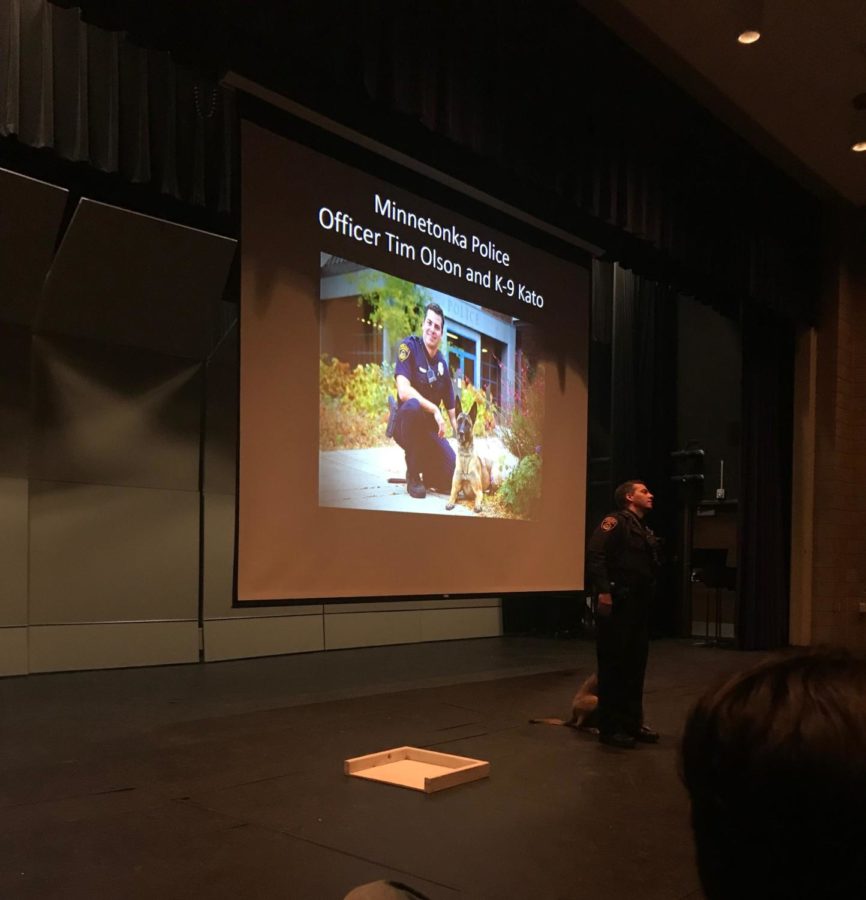Psychology Students Attend Minnetonka K-9 Demonstration
Minnetonka police officer Tim Olson shows Orono psychology students how the department uses operant conditioning to train police dogs
Kristin Pearson
Visuals Editor
On Dec. 11 2018, Orono psychology students attended a K-9 demonstration given by Minnetonka police officer Tim Olson. In AP Psychology and General Psychology, students are learning about learning. This demonstration was to show how police dogs are trained using operant conditioning, a topic that is heavily discussed during the learning unit.
“In class, we are learning about the various ways that we learn,” psychology teacher Sarah Ibs said. “One of those ways is operant conditioning and we learn the basic components in class and we talk about different examples, but I always think if there’s an opportunity to get a real world example of what we are learning, it can be so much more beneficial and helpful.”
Olson introduced himself, and shortly after introduced the two Minnetonka police dogs, Duke and Kato (the latter made a live appearance later in the presentation). These two dogs are of the Belgian Malinois breed. A breed that, as Olson explained, is highly motivated and highly energetic, making them perfect for this line of work. In the Minnetonka police department, the dogs are dual purpose, meaning that they are used for both patrol duties and narcotic-based tracking.
Any time that we can connect with the community and learn from community members, it can be beneficial and helpful too,For me, it’s making a real world connection with what we learn about in class.
— Sarah Ibs
These dogs receive over 200 hours of training a year from the department. One example given is how they learn to track the scent of humans. The officer puts food on the ground where a human has recently been and the hungry dog eats that food. The food is removed little by little from the training area, until the dogs associates the smell of human with the receival of food, even in the absence of food. The dog is not conscious of the fact that it is looking for a human, it is just sniffing for treats
“It’s all a big game for the dog,” Olson said.
Simply Psychology defines operant conditioning as “A method of learning that occurs through rewards and punishments for behavior. Through operant conditioning, an individual makes an association between a particular behavior and a consequence.” The use of operant conditioning was shown through a live demonstration with Kato. Olson gave her several commands, all of which she obeyed immediately, and she was then rewarded with pieces of hot dog. Because she associates those behaviors with the positive consequence of receiving snacks, she knows that she will not get the snack if she does not obey the commands, and therefore has learned, through operant conditioning, to do what she is told to.
Student interest was high during the presentation, particularly when Kato made her appearance. They asked several questions including “Does Kato live with you?” and, of course, “What happens if the suspect has a hot dog?”
“Any time that we can connect with the community and learn from community members, it can be beneficial and helpful too,” Ibs said. “For me, it’s making a real world connection with what we learn about in class.”

My name is Kristin Pearson. I am a Visuals Editor of The Spartan Speaks. I am a senior and I love newspaper, yearbook, and theater.











